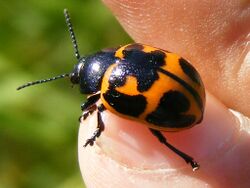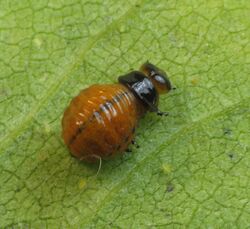Biology:Milkweed leaf beetle
| Milkweed leaf beetle | |
|---|---|

| |
| Scientific classification | |
| Domain: | Eukaryota |
| Kingdom: | Animalia |
| Phylum: | Arthropoda |
| Class: | Insecta |
| Order: | Coleoptera |
| Infraorder: | Cucujiformia |
| Family: | Chrysomelidae |
| Genus: | Labidomera |
| Species: | L. clivicollis
|
| Binomial name | |
| Labidomera clivicollis (Kirby, 1837)
| |
| Synonyms[1] | |
| |
The milkweed leaf beetle (Labidomera clivicollis) is a species of leaf beetle from the family Chrysomelidae.[2] It is round bodied, 8–11 mm in length with a black head and pronotum and bright orange to yellow elytra with variable mottled black patches. Its colored and shaped like a super-sized ladybird beetle even though the ladybird is in a different family, Coccinellidae. The larva is shaped much like the adult except with a small tail extension. Its color varies from bright orange to white with a gray to black pronotum and prominent black spots around its spiracles.
Diet
There are a number of L. clivicollis host plants which are toxic to most herbivores. Many are in the dogbane family (Apocynaceae) including milkweeds, especially swamp milkweed (Asclepias incarnata) and common milkweed (Asclepias syriaca); swallow-wort (Cynanchum); twinevine (Funastrum).[1] Others are in the nightshade family (Solanaceae) including Carolina horsenettles (Solanum carolinense).
Life cycle
The female lays small groups of orange jellybean-like eggs of its host plant.
Miniature sized larvae, about the same shape as later instars, hatch in about a week and graze night and day. File:Milkweed leaf beetle larvae.webm
Finally the mature larvae move to the soil to pupate. After a few weeks, adults emerge to start the next generation eating the same host plants as the larvae. An adult may displace a monarch larvae to feed at the same site.[3]File:MilkweedBeetle Adult.webm
As autumn approaches, the adults feed and eventually find places to shelter through the winter.[4]
Acquired protection
The bright coloration of the milkweed leaf beetle is a classic example of Aposematism. Several insects that share some of the same hosts sport similar warning coloration: monarch, milkweed tussock moths, milkweed beetles and milkweed bugs and hence illustrate Műllerian mimicry.
These insects have evolved the ability to thrive on these plants despite the presence of noxious poisons the plants have evolved to protect themselves from most herbivores. These toxins help protect these insects from being eaten by visually gifted predators like birds that regularly prey on caterpillars, butterflies, and beetles. The conspicuous orange and black colors serve as a reminder of a potentially nasty gastronomic misadventure to experienced birds and other predators that may have attempted to make a meal of them.[3] [1]
References
| Wikimedia Commons has media related to Labidomera clivicollis. |
- ↑ 1.0 1.1 1.2 "Species Labidomera clivicollis - Swamp Milkweed Leaf Beetle". BugGuide.net. http://bugguide.net/node/view/2970.
- ↑ "Labidomera clivicollis (Kirby, 1837)". Integrated Taxonomic Information System. https://www.itis.gov/servlet/SingleRpt/SingleRpt?search_topic=TSN&search_value=720107.
- ↑ 3.0 3.1 "Hey beetles, leave some milkweed for the monarchs: Milkweed leaf beetle, Labidomera clivicollis". 2020-07-27. https://bugoftheweek.com/blog/2020/7/27/hey-beetles-leave-some-milkweed-for-the-monarchs-milkweed-leaf-beetle-labidomera-clivicollis.
- ↑ "MDC Field Guide - Swamp Milkweed Leaf Beetle". Missouri Department of Conservation. https://mdc.mo.gov/discover-nature/field-guide/swamp-milkweed-leaf-beetle.
Wikidata ☰ Q3214341 entry
 |


